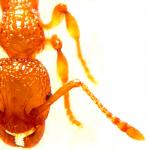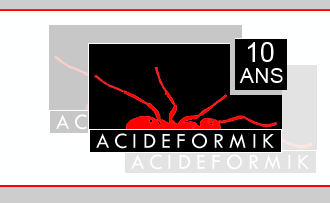Bienvenue invité ( Connexion | Inscription )
 Thursday 26 November 2009 à 12:26 Thursday 26 November 2009 à 12:26
Message
#1
|
|
 Myrmécomorphe Groupe: Contributeurs Messages: 5 633 Inscrit: 20/08/2007 Lieu : Armentières (59) Membre No.: 1 645 |
Un premier document sur les modes de déclenchement de la diapause chez les fourmis :
THE ANTS p.295 (Bert Hölldobler,Edward O. Wilson) CITATION(Bert Hölldobler,Edward O. Wilson : THE ANTS p.295) MEDIATION OF LARVAL DIAPAUSE : Colonies of most ant species in the north temperate zone undergo some form of diapause during the late fall and winter. The metabolic rate and locomotor activity slow down drastically and reproduction ceases. In the genus Camponotus, the species of which usually nest in fresh and decaying wood and hence are called carpenter ants, the adults and brood enter diapause in the cold season (Hölldobler, 1961). Similarly, most myrmicine species overwinter with larvae in the nest, and these immature stages also pass through a diapause of their own. In most organisms diapause is entrained by a shortening of the daily photoperiod, which is by far the most reliable "calendar" available. Wokers of Myrmica rubra have been proved use photoperiod (Brian, 1986), and there is no reason to expect otherwise for adults of ants generally. On the other hand a mystery remains. Ant larvae are hidden by the adults in soil or rotting vegetation, and thus live in permanent darkness. How do they measure the change in season and choose to enter diapause? Weir (1959) proved that fall ("serotinal") workers of Myrmica tend to induce diapause in terminal-instar larvae, whereas spring ("vernal") workers cannot. This result was achieved by keeping workers in the laboratory at the warm temperature of 25°C for 11 weeks after lengthy chilling to simulate in them the physiological state of wild spring condition. The "fall" workers could induce diapause ; the "spring" workers could not. Closely similar experiments were performed by Kipyatkov (1979, 1988) on M. rubra in the Soviet Union, with the same result. Weir further guessed that diet might be the key, since Myrmica workers are known to increase the proportion of protein in the diet as the season progresses, and dormant larvae have a higher nitrogen-to-car-bon content in their maconia and fat bodies than do nondormant larvae. When Weir fed spring workers a sufficiently increased amount of protein (by means of a pure diet of Drosophila), it turned out that they too were able to induce dormancy. Weir, after concidering the matter at length, remained uncertain whether the larval dormancy is true diapause in the purest sense, in other words a shut-down mediated by the endocrine system. Still, it qualifies as diapause in the broad sense that, once initiated, it is persistent in its effect, even at raised temperatures. Kipyatkov is in substantial agreement. In addition, he has provided evidence of a remarkable new volatile pheromone from spring workers that reactivates diapausing larvae and queens. Rien de bien nouveau : juste un petit rappel sur la complexité du déclenchement de la diapause et des influences perturbatrices que l'on peut avoir en élevage sur leur cycle naturel. PS : une belle petite traduction serait pas de refus. D'avance merci -------------------- |
|
|
|
Les messages de ce sujet
 sipatte [documentation] Les déclencheurs de diapause Thursday 26 November 2009 à 12:26
sipatte [documentation] Les déclencheurs de diapause Thursday 26 November 2009 à 12:26
 SA_Ka_20 Insomnie, quand tu nous tiens...
Désolé grimmjow... Friday 27 November 2009 à 07:16
SA_Ka_20 Insomnie, quand tu nous tiens...
Désolé grimmjow... Friday 27 November 2009 à 07:16
 hugo Cher ami Soit, selon les espèces, les larves so... Saturday 05 December 2009 à 14:39
hugo Cher ami Soit, selon les espèces, les larves so... Saturday 05 December 2009 à 14:39
 sipatte Merci hugo
Je me doutai bien que des espèces q... Saturday 05 December 2009 à 18:41
sipatte Merci hugo
Je me doutai bien que des espèces q... Saturday 05 December 2009 à 18:41
 hugo CITATIONEs-tu vraiment sûr que l'absence d... Saturday 05 December 2009 à 21:15
hugo CITATIONEs-tu vraiment sûr que l'absence d... Saturday 05 December 2009 à 21:15
 sipatte Un autre document très intéressant et complet sur ... Saturday 05 December 2009 à 21:34
sipatte Un autre document très intéressant et complet sur ... Saturday 05 December 2009 à 21:34
 sipatte Un ou plusieurs volontaires pour une belle traduct... Monday 07 December 2009 à 14:45
sipatte Un ou plusieurs volontaires pour une belle traduct... Monday 07 December 2009 à 14:45  |
5 utilisateur(s) sur ce sujet (5 invité(s) et 0 utilisateur(s) anonyme(s))
0 membre(s):
Partagez ce sujet sur un forum (bbcode):
Partagez ce sujet sur un site web ou un blog (html):
| Version bas débit |











